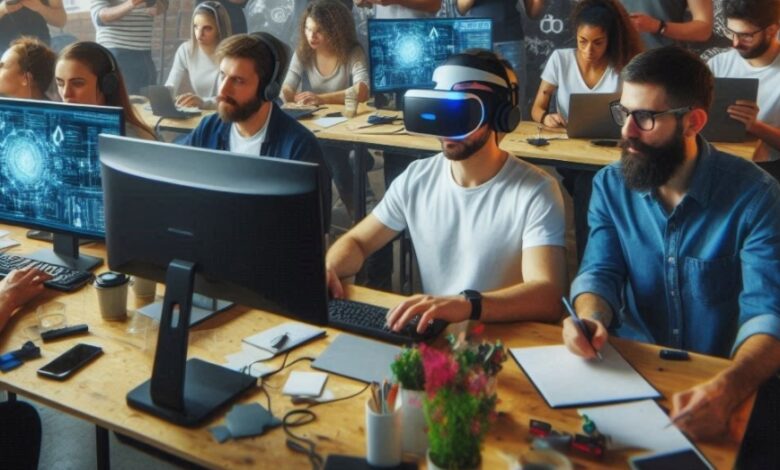Leveraging the Gaming Potential of Virtual Reality Solutions: Innovation for an Immersive Virtual Experience

As its appeal grew at an astronomical rate, virtual reality has captured players and changed the way audiences perceive digital environments. These solutions to VR gaming have achieved a unique niche in the broader spectrum of the video game industry, providing visceral opportunities to immerse, interact, and explore new worlds. The latest innovations in this space take the term “engagement” to a new level by turning VR experiences into a compelling form of art, technology, and storytelling. With the growing demand for VR solutions, studios all over the world start to find opportunities to break the boundaries while maintaining affordability and accessibility for broader audiences.
- The Development of VR Game Solutions
The course of VR gaming solutions has been marked by a series of technological leaps. Initially, these experiences appeared somewhat raw, limited in their imagery and interactions and locked down to the capabilities of early-generation hardware. However, rapid progress means that significantly more sophisticated solutions have now arrived-those which will engage with lifelike visuals, precise motion tracking, and intuitive control schemes. Today’s headsets and peripherals are high-definition displays with spatial audio, producing convincing environments that seem to wrap around the user.
One such factor driving this evolution is the convergence of multi-technologies. High-performance graphics processing, motion capture, artificial intelligence, and even haptic feedback have appeared together to enable extremely immersive gaming environments. New VR solutions enable users to interact with digital worlds in unprecedented ways, to manipulate objects, explore complex settings, and engage with intelligent characters. This outcome results in a new standard of engagement that transcends traditional gaming and appeals to diverse audiences, from casual players to competitive gamers.
- Creating Immersion Through Narrative and Gameplay
The defining characteristic of VR gaming is the ability to present realistic narratives that pull the player into completely new worlds. Developers have adapted from merely providing mechanics to creating stories as they emerge through user exploration and interaction. Most of the time, within VR, the player is the protagonist: He or she has choices that will point the story in a different direction, giving the story the opportunity to feel very personal and engaging.
Crafting intuitive-yet-complex environments that feel natural allows players to act like they want while shepherding them to the key experiences in VR game design is no easy task. Innovations such as gaze-based control systems, realistic physics simulations, and adaptive character AI add depth to gameplay experience and make sure virtual worlds are responsive and alive. This makes the most out of the engagement between users, as they experience life as participants and observers at the same time.
Despite the impressive technological advancements in VR gaming, affordability remains a significant consideration for consumers and developers alike. High production costs and complex development cycles often lead to premium pricing for VR titles, creating barriers to entry. To address this challenge, many VR gaming development studios are exploring strategies to reduce costs without sacrificing quality. Affordable VR game development services are gaining popularity, using modular design principles, reusable assets, and streamlined production processes to make immersive experiences more accessible.
Affordability is further driven by collaboration between development studios and hardware manufacturers. By developing optimized experiences on particular hardware, studios can leverage superior performance while minimizing requirements for high-end systems. Open-source development tools and available pre-built frameworks enable even more minor studios to enter the market with new solutions, giving rise to a greater variety of available experiences.
- The role of innovation in driving engagement
Innovation lies at the heart of every successful solution for VR gaming. With bold creative ideas combined with leading technology at their core, studios can produce unique experiences that differentiate themselves from the crowd. Innovations in user interfaces, such as hand-tracking and voice recognition, provide new ways for players to interact with virtual environments. For example, users no longer have to rely on controllers to manipulate objects but can instead use their own hands to reach out, which adds a tactile dimension to the experience, making immersion much more effective.
Experiences in VR that are multiplayer are yet another space that witnessed vast growth and innovation. Social VR platforms combined with competitive games have enabled significant communities that let users connect, collaborate, or compete. Shared experiences enhance player engagement through meaningful social interactions that build relationships beyond the game. These social interactions blur the distinction between digital and physical friendships, often carrying over into real-world interactions.
- The Rise of VR Gaming Development Studios
VR gaming development studios play a crucial role in shaping the direction of the industry. By leveraging their expertise and creative vision, these studios introduce experiences that challenge our perceptions of reality and push technical boundaries. Studios around the world, from established firms to independent teams, bring diverse perspectives to the development process. Each project offers something unique, whether through stunning visuals, innovative mechanics, or deeply emotional narratives.
Studios are sometimes partnering with researchers and technologists to push VR beyond pure entertainment. Projects that concentrate on mental health therapies, immersive storytelling, or interactive training modules, for example, are some of the most promising applications for improving life.
While studios often have their genre niches- horror, fantasy, sports, for example-there is another type where studios centre on broader applications of VR pushing the limits of what’s possible.
- Inclusive Accessibility in VR
One of the most exciting developments in modern VR is that it’s becoming inclusive with accessibility and design. Developers are creating systems that accommodate a wide variety of physical abilities, languages, and cultural perspectives so that absolutely everyone is included for immersive experiences. This push for inclusivity allows users who may not have been able to engage in such experiences with traditional gaming to enter virtual worlds and experience the same wonder and interaction.
Most times, inclusive design involves careful testing, collaboration with different communities, and the development of alternative control schemes. This dedication to accessibility creates more fun and socially impactful VR games solutions, making a broader and more connected user base.
- Virtual Reality as a Learning Platform
From an entertainment perspective, while the most attention is upon entertainment, it has shown incredible potential as educational tools. Simulations can place users in scenarios where they could practice skills, historical events, or complex systems without any disastrous consequences in the real world. Educational applications, blending gameplay with structured learning modules, take even the most difficult concepts and make them accessible and fun by re-shaping how knowledge would be transferred and retained.
The impact of VR learning extends to professional training as well. Industries such as healthcare, aviation, and engineering are using VR to simulate high-pressure scenarios where trainees can practice and refine their skills. By blending gaming principles with training objectives, developers create experiences that are not only effective but enjoyable.
- Future Opportunities for Engaging VR Experiences
Future of VR gaming solutions is exciting and unpredictable. They would combine the newer technologies like augmented reality, artificial intelligence, and spatial computing with existing VR systems, creating hybrid experiences that blend physical and digital realities. These integrations will likely result in virtual objects being able to be “tactilely” present in the real world, further stepping up the immersion.
Advances in artificial intelligence promise better, more intelligent, adaptive, and believable VR characters and environments. Characters driven by AI that react dynamically to a player’s actions and conversations will lend an authenticity to virtual worlds, making them less scripted and more authentic. On the other hand, adaptive environments that react according to user preferences and behavior ensure that everything is fresh, with no two experiences alike.
- Designing the Future of Experiences
Whether VR gaming will be a success in the years to come depends largely on whether studios can create meaningful, innovative, and accessible experiences. With advancing technology and emerging creative visions, what is possible in virtual environments will continue to grow. What is interesting is the full potential of VR gaming solutions through which developers can reach for the stars, inspire, educate, and entertain.
As these new technologies change the VR game development landscape, the definition of creativity, accessibility, and affordability from committed gaming development studios defines the next generation of immersive entertainment. The dynamic and constantly evolving industry shows that virtual experiences are not just easily accessible escapades but serve as the means through which human imagination merges with technology to give way to much more profound adventures.





